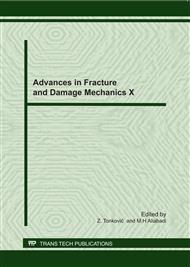p.69
p.77
p.81
p.85
p.89
p.93
p.97
p.101
p.105
Crystallographic Analysis of Specimens Used for Calibrate a Failure Model for an Al 6061 – T6 Alloy
Abstract:
Calibration and exploitation of failure criterion is at present a challenging field in the structural integrity scenario. Calibrated failure criteria allow the simulation/reproduction of damages using virtual approach and eventually further assessment of the residual integrity of the components. Therefore the increase of awareness in failure issues makes the numerical simulation an actual, useful and reliable tool for the analysis of complex structures under extreme loads, especially in aerospace field where full scale tests are often very expensive and difficult to carry out. With this aim, the constitutive relations of an Aluminium Al 6061-T6 alloy have been calibrated with dedicated focus on failure criterion. The results obtained have been discussed considering the crystallographic measurements that permit to point out the dissipative behavior on the basis of texture formation as a function of the load type. The final aim is to confirm and explain the different failure behavior depending on the different stress triaxiality.
Info:
Periodical:
Pages:
89-92
Citation:
Online since:
September 2011
Keywords:
Price:
Сopyright:
© 2012 Trans Tech Publications Ltd. All Rights Reserved
Share:
Citation:


